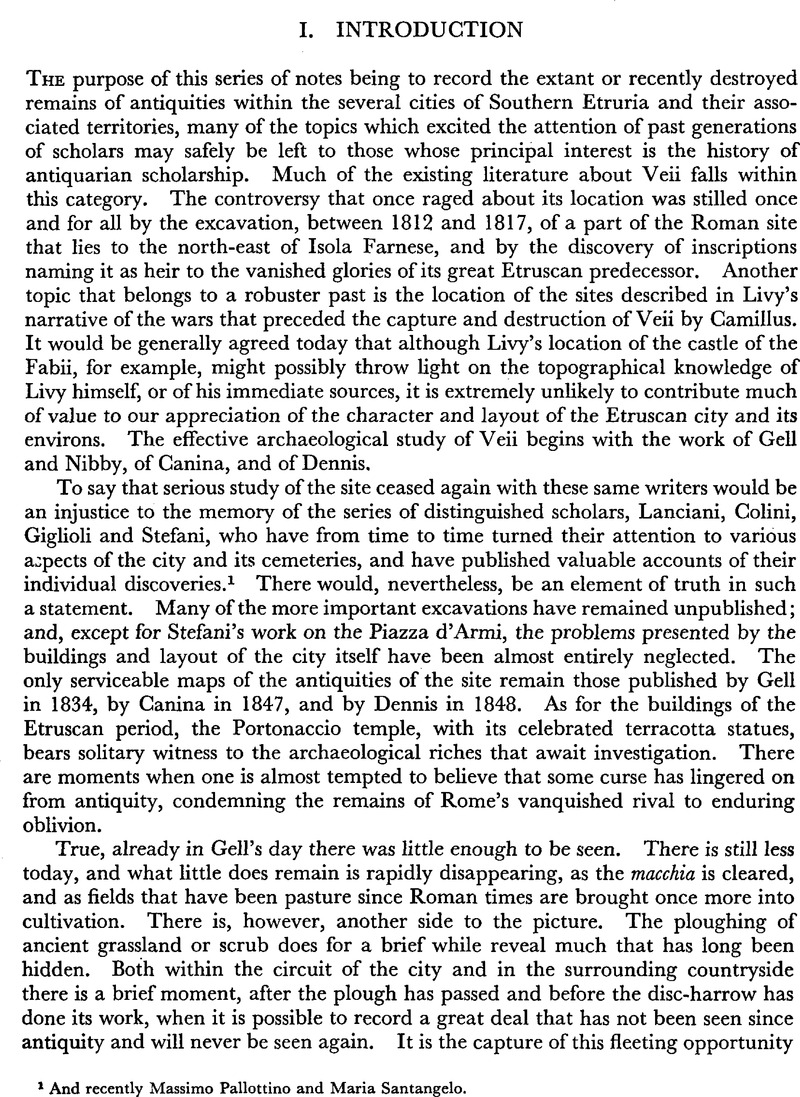No CrossRef data available.
Published online by Cambridge University Press: 09 August 2013

page 86 note 1 AE in ligature.
page 86 note 2 Certainly to be taken as a title of Fortuna, although the singular form is not otherwise attested except by the Grammarians, cf. Rose and Vitucii, loc. cit. Fortuna appears among the Di Penates in Pompeii; Vitucci also compares F(ortuna) D(omestica) at Lorium (CIL, XI, 3730)Google Scholar and cites literary evidence for the inclusion of Fortuna among their Penates by the Etruscans (see also Weinstock, S., RE, XIX, col. 456)Google Scholar.
page 86 note 3 Probably for ceterisque diis or diisque omnibus, cf. e.g. ILS, 3597, diis deabus Penatibus … ceterisque diibus.
page 86 note 4 The name is not otherwise attested, but Vitucci argues that it derives from an Etruscan root.
page 87 note 1 None of the nomina have been previously recorded at Veii. Cartilius is found at an early date in Etruria (cf. Schulze, , Zur Geschichte Lateinischer Eigennamen, p. 145)Google Scholar but does not seem common there later when its most notable bearers are from Ostia; it may imply Etruscan connexions here, but is perhaps as likely to be immigrant as is Nouius and probably the half-read nomen (? Aerentia) in 1. 6.
The mother's cognomen in 1. 6 suggests a family of freedmen origin.
page 87 note 2 No other instance of this title has been previously recorded at Veii. It was presumably defined in the second half of the line.
page 87 note 3 It is impossible to be sure that nothing was inscribed before s at the beginning of this line, but the text proposed gives a reasonable layout.
page 87 page 4 The gap in 1. 4 contained Cartilia's cognomen; 1. 5 may have contained a laudatory adjective—it would be just possible, although not entirely satisfactory, to read v. be[ne v. me]reṇ[ti et]—or the name and description of another relative.
page 87 note 1 Cf. CIL, X, 6081Google Scholar, from Formiae, an imperial freedman procurator tractu Campan(iae).
page 87 note 1 From their names, the brothers are likely to be freedmen or of freed origin, the patron probably being the emperor Hadrian. For another P. Aelius at Veii cf. CIL, XI, 7756, 1. 8Google Scholar.
page 87 note 1 This cognomen marks the brothers as of freedmen origin. Their praenomina and nomina suggest connexion with the family of M. Arrecinus Clemens, cos 73.
page 87 note 2 Traces of the next line are faintly visible—perhaps [fecit e]ṭ ![]() [bi].
[bi].
page 88 note 1 Probably a tombstone, erected to the freedman Teucer by his own freedman. Fadii have not been previously recorded at Veii, but they are not uncommon in Rome from the late Republic onwards and there is a scatter of them in Etruria and Umbria.
page 88 note 1 Suggesting that the subject was a priestess of Isis.
page 88 note 2 Possibly Suç[ces/sa]ẹ. The letters that follow may be from the nomen of the husband or other relative who erected the monument.